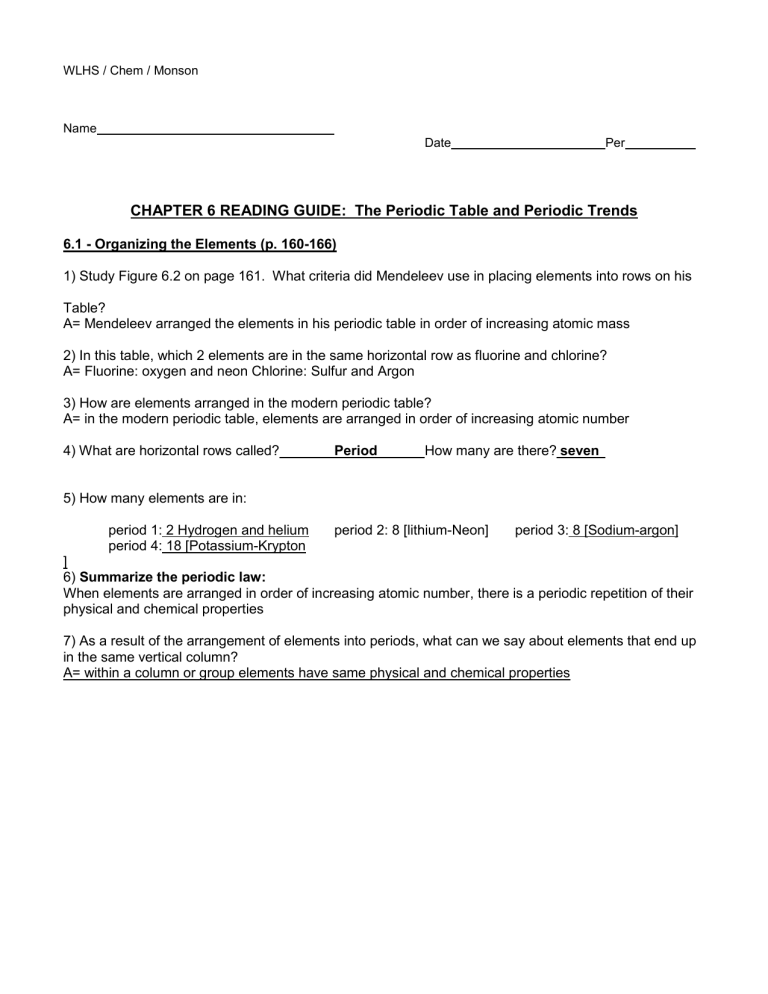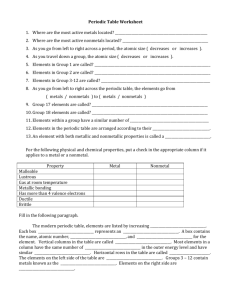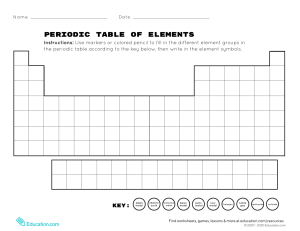
WLHS / Chem / Monson Name Date Per CHAPTER 6 READING GUIDE: The Periodic Table and Periodic Trends 6.1 - Organizing the Elements (p. 160-166) 1) Study Figure 6.2 on page 161. What criteria did Mendeleev use in placing elements into rows on his Table? A= Mendeleev arranged the elements in his periodic table in order of increasing atomic mass 2) In this table, which 2 elements are in the same horizontal row as fluorine and chlorine? A= Fluorine: oxygen and neon Chlorine: Sulfur and Argon 3) How are elements arranged in the modern periodic table? A= in the modern periodic table, elements are arranged in order of increasing atomic number 4) What are horizontal rows called? Period How many are there? seven 5) How many elements are in: period 1: 2 Hydrogen and helium period 4: 18 [Potassium-Krypton period 2: 8 [lithium-Neon] period 3: 8 [Sodium-argon] ] 6) Summarize the periodic law: When elements are arranged in order of increasing atomic number, there is a periodic repetition of their physical and chemical properties 7) As a result of the arrangement of elements into periods, what can we say about elements that end up in the same vertical column? A= within a column or group elements have same physical and chemical properties Category: Properties? They are good conductors of heat, it has high luster surface all metals are solid at room temperature except for mercury, they can reflect light, ductile, malleable, crystal or amorphous structure. Chemical: Metals in G1 and G2 are very reactive. Transition metals are the less reactive Examples Sodium, Iron and magnesium Metals Where on table? They are located Between group 1 and group 12 includes alkali, alkaline earth and transition metals Most nonmetals are gases at room except from bromine which is liquid temperature they are poor conductors of electricity and heat, they have odor Carbon, Neon and Fluorine Nonmetals They are located from group 14 to 18 includes nonmetals and noble gases including Hydrogen Metalloids They are located from G13 to G17 in form of a stair case between other metals and nonmetals. Chemical G18 contains the less reactive and G17 contains the most reactive elements forming compound in the environment. They generally have the similar properties that metals and nonmetals have under certain conditions they can have metal properties and under other conditions they might have nonmetal. Boron, Silicon and Arsenic 8) Complete the chart below summarizing the 3 broad classes of elements. 6.2 - Classifying the Elements (p. 167-173) 9) What chemical properties do the noble gases share and how does this relate to their electron configuration? A= Noble gases are unreactive (inert). They have 8 electrons in their valence shell or outermost energy level (stable octet). 10) For each element tell which period and group the element is in, identify the element, and state whether it is a metal, nonmetal, or metalloid. Element Period Group Identity Metal, nonmetal, metalloid? #34 #40 #14 #56 4 5 3 6 16 4 14 2 symbol Se and atomic number 34. Symbol Zr atomic number 40 Symbol Si atomic number 14 Symbol Ba atomic number 56 Nonmetal Metal Metalloid Metal #18 #4 #82 #37 3 2 6 5 18 2 14 1 Symbol Ar atomic number 18 Symbol Be atomic number 4 Symbol Pb atomic number 82 Symbol Rb atomic number 37 Nonmetal Metal Metal Metal 11) Classify the following as metals, nonmetals, or metalloids: A) Manganese: metal D) nitrogen: nonmetal B) Arsenic: metalloid E) niobium: metal C) carbon: nonmetal F) radium: metal 12) Iodine is used in many commercial chemicals and dyes. To what family does it belong? What are the other members of this family? How many electrons are in the outermost energy level (valence electrons)? A= Iodine belongs to group 17 and it belongs to the halogens family, the other member contain fluorine, chlorine, bromine and astatine, and they have 7 valence electrons in the last level of energy or shell. 6.3 – Periodic Trends (p. 174-183) 13) Explain WHY as you go down the periodic table, within a group, atomic radius increases. A= 14) Explain why Cl (#17) is smaller then S (#16) considering it has one more proton than sulfur. 15) Arrange these elements in order of DECREASING atomic size: A) S, Cl, Al, Na, Si, Mg, Ar, P: Na, Mg, Al, Si, P, S, Cl, Ar B) Sb, Sr, Te, I, In, Xe, Rb: Rb, Sr, In, Sb, Te, I, Xe C) Se, Po, O, S, Te: Po, Te, Se, S, O D) Cs, Na, Li, H, Fr, Rb, K: Fr, Cs, Rb, K, Na, Li, H 16) Which element in each pair has the greater atomic radius (size)? A) SODIUM or LITHIUM D) STRONTUIM or MAGNESIUM B) CARBON or GERMANIUM E) SELENIUM or OXYGEN C) BROMINE or FLUORINE F) BISMUTH or THALLIUM 17) What is a CATION? A cation is a positively charged ion, i.e one that would ne attracted to the cathode in electrolysis. How does a CATION form? A cation forms when an atom losses one or more e- from its electron cloud 18) What is an ANION? An anion is an atom that has more electrons than protons, in other words, an anion is an atom with a negative charge How does an ANION form? An anion forms when ana atom gains one or more e- in its electron cloud. 19) Define IONIZATION ENERGY and describe its trend on the periodic table. (what happens and WHY?) ionization enery is the quantity of energy that an isolated, gaseous atom, in the ground electronic state must absorb to discharge an electron, resulting a cation 20) Which element in each pair has the LARGER ionization energy? (circle) A) BORON or NITROGEN D) ALUMINUM or SODIUM B) FLUORINE or CHLORINE E) CARBON or SILICON C) BARIUM or CALCIUM F) CHROMIUM or COBALT 21) How does the radius / size of a typical ANION compare with the radius / size of its corresponding neutral atom? EXPLAIN why this trend is observed. 22) Arrange the following elements in order of INCREASING ionization energy: A) Ba, Be, Mg, Ca, Sr: B) Bi, Pb, Cs, At, Ba: C) Na, P, Al, Cl, Mg, S: D) Rb, Na, K, Cs, Li: E) Te, S, O, Po, Se: 23) Define ELECTRONEGATIVITY and describe its trend on the periodic table. (what happens and WHY?)



